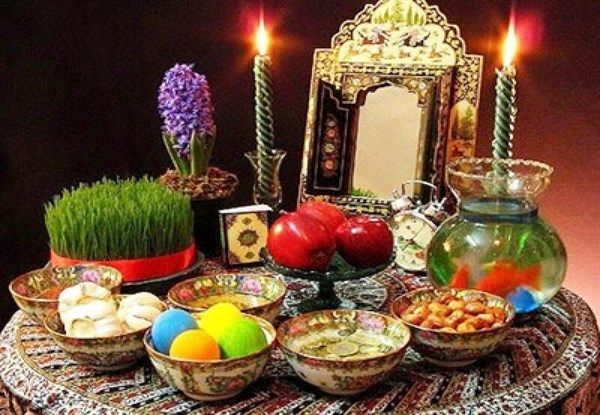Iranians to celebrate Nowruz, overshadowed by pandemic

TEHRAN.(Iranart) –For the second year, millions of Iranians in Iran and abroad will celebrate Norouz, the Persian New Year, amid the coronavirus pandemic.
In Iran, the New Year begins with the advent of spring, and everyone observes it by celebrating a season of new life, and wishing for good luck in the year ahead.
Last year, Iranians began the New Year while more than 1,100 people died in Iran as a result of the coronavirus outbreak.
This year, over 2.5 million people worldwide have lost their lives due to the coronavirus pandemic. However, the long-rooted tradition of Norouz remains.
The National Headquarters for Managing and Fighting the Coronavirus has not issued any ban on public transportation companies from offering services during the upcoming Iranian New Year holidays (March 21-April 2).
“Compliance with guidelines related to COVID-19 is the only requirement for operations of air, rail and road transport providers,” Minister of Roads and Urban Development Mohammad Eslami told IRIB News.
In the Persian language, Norouz is taken from No (new) and rouz (day). It means ‘new day’, symbolizing new life, and new beginnings. Every year, Norouz coincides with the start of spring, which traditionally celebrates the rebirth of nature.
In recognition of the importance of this ancient rite, Norouz was inscribed on the UNESCO Representative List of the Intangible Cultural Heritage of Humanity in 2009. The UN General Assembly recognized March 21 as the International Day of Norouz in 2010. More precisely, however, Norouz marks the day of the vernal equinox in the Northern Hemisphere, which can occur anytime between March 19-21, depending on the year as well as one’s location. Canada also passed a law recognizing March 21 as Norouz Day.
UNESCO has registered Norouz celebrations as shared practices of 12 countries. Azerbaijan, India, Iran, Kyrgyzstan, Pakistan, Turkey and Uzbekistan were listed by the UN agency in 2009 as countries where Norouz is celebrated. A new proposal was drawn up in 2016 to include five more countries, namely, Afghanistan, Iraq, Kazakhstan, Tajikistan and Turkmenistan.
The Norouz celebrations culminate with the countdown to the New Year, with families gathering around what is known as the haft seen table. In line with the literal meaning of its name — ‘haft’ means the number seven, while ‘seen’ refers to the letter ‘s’ in the Persian language.
Haft seen has a rather complex history, having evolved from Haft-Shin of the Kayanids dynasty to Haft-Chin of the Achaemenids dynasty, and to its current Haft seen since the writing of ‘Shahnameh’ (‘Book of Kings’) — the epic poem of Persian kings, written by Ferdwosi about 1,000 years ago.
In fact, the word haft denotes the seven days of ‘creation’.
According to cmes.fas.harvard.edu, in addition, each of them has their own symbolism, as outlined by a teaching resource on Norouz published by Harvard University’s Center for Middle Eastern Studies.
The following items appear on a haft seen table:
- Sumac (crushed spice from berries): For sunrise and the spice of life
- Senjed (sweet dry fruit of the lotus tree): For love and affection
- Serkeh (vinegar): For patience and age
- Seeb (apple): For health and beauty
- Seer (garlic): For good health
- Samanu (wheat paste): For fertility and the sweetness of life
- Sabzeh (sprouted wheat): For rebirth and renewal of nature
In Tehran, a photo exhibition opened on March 15 at the Azadi Art and Cultural Complex with an exhibition of photos on haft seen.
The photo exhibit features 62 photos by veteran photographers Hassan Ghaffari and Alfred Yaqubzadeh.
The museum is home to old cameras and equipment dating back to 170 years ago in addition to old photos from the collection of veteran photographer Mohammad-Ali Jadidoleslam.
Several veteran photographers were honored at the opening ceremony while Narges Raadman, the photographer of health defenders, who is also attending the exhibit with one of her haft seen spreads, was honored.
According to menafn.com, Norouz owes its survival to many individuals and phenomena.
Renowned Muslim scholars, such as the Persian Abu Rayhan Muhammad ibn Ahmad al-Biruni, known as Biruni (973-1048), and Mahmud ibn Hussayn ibn Muhammed al-Kashgari (1005-1102) were among the many intellectuals who studied the date of Norouz.
Ferdowsi, the eminent Persian poet of the 11th century who composed the ‘Shahnameh’ (‘Book of Kings’), chronicles the story of Norouz and its evolution in his epic in the finest terms.
Shortly after him, Omar Khayyam (1048-1131), an Iranian polymath, mathematician, astronomer, and poet developed the Jalali calendar upon the instruction of Jalaleddin Malik-Shah I of Seljuk in 1079 A.D., which calculated a year to be 365.242 days long, accurate to the sixth decimal place.
The Jalali calendar is reputed to be one of the most precise and reliable in the world. And then there were the Iranians, Afghans, Tajiks, Turkmens, Turks and other peoples in the region who faithfully treasured and preserved rituals associated with Norouz, galvanizing the delivery of this rich historical, cultural asset to its inheritors: The younger generations. And let’s not forget the endeavors of artists, authors and intellectuals to safeguard Norouz through their creative works and scintillating literary and visual productions.
Source: Iran Daily

